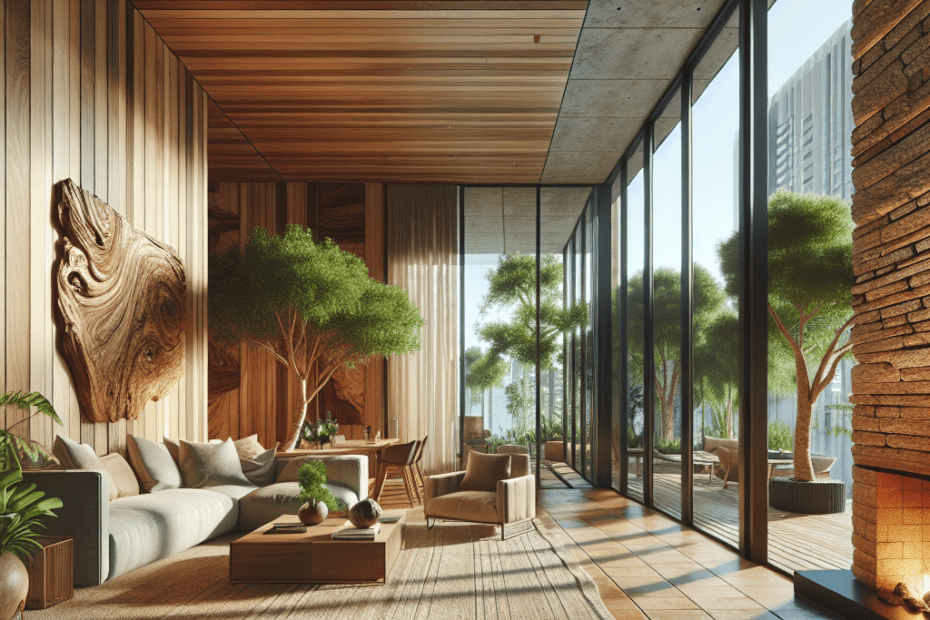“`html
Introduction
In recent years, homeowners and designers have embraced a growing trend towards sustainability and environmental consciousness. They are increasingly seeking ways to integrate eco-friendly elements into their contemporary homes. Natural materials in design play a vital role in achieving this goal. Not only do natural materials offer aesthetic appeal, but they also provide a range of environmental benefits. This blog post explores how to seamlessly incorporate natural materials into modern homes, thereby promoting both style and sustainability.
The Importance of Natural Materials in Design
Natural materials such as wood, stone, bamboo, and clay have been used in construction for centuries. Today, they resonate deeply with those who wish to create living spaces that reflect a connection to nature. According to a report by the National Association of Home Builders, 38% of homeowners cite sustainability as a key consideration when undertaking home improvements (Source: NAHB).
Techniques for Integrating Natural Materials
1. Wood Elements
Wood is perhaps the most versatile natural material used in design. From flooring and ceilings to furniture and wall finishes, wood can be incorporated in numerous ways. Reclaimed wood is particularly popular as it offers a rustic charm while being environmentally friendly. It’s beneficial to source wood locally to reduce carbon emissions associated with transportation.
2. Stone Accents
Stone adds a timeless elegance to any home. Granite and marble bring a luxurious touch to contemporary kitchens and bathrooms. Meanwhile, river rock and limestone can be used for more earthy, organic exteriors or interior feature walls. They not only add aesthetic value but also increase the property’s resale value.
3. Bamboo Flooring
Bamboo is rapidly gaining popularity as a sustainable flooring option. It is not only durable but also regenerates quickly compared to traditional hardwoods. Using bamboo flooring can create a modern yet warm ambiance, making it ideal for both minimalist and extravagant designs.
4. Plant-Based Textiles
Incorporating natural materials involves more than just structural elements. Soft furnishings such as cotton, linen, and jute add a touch of nature to living spaces. They not only enhance visual and tactile appeal but also ensure breathability and comfort. According to a 2020 survey by Textiles 2030, 54% of consumers prefer sustainable textiles for home interiors (Source: Textiles 2030).
5. Clay and Earthy Textures
Clay tiles and earthen textures in walls or as decorative elements can bring natural warmth and character into a home. Clay is also an excellent material for crafting bespoke items such as pottery or vases, adding a dash of personality to the decor.
6. Green Living Walls
Introducing living walls in homes is a significant trend that seamlessly integrates nature into contemporary interiors. They not only improve air quality but also add a striking visual focal point. Additionally, living walls can be customized with various plant species to fit the homeowner’s preferences and environmental conditions.
Statistics on Natural Material Usage
To understand the impact and growing trend of natural material usage in homes, consider the following statistics:
| Material | Percentage Use in New Constructions (%) | Growth Rate from 2015 to 2023 (%) |
|---|---|---|
| Reclaimed Wood | 30 | 50 |
| Stone | 40 | 30 |
| Bamboo | 20 | 65 |
| Plant-Based Textiles | 54 | 40 |
Key Takeaways
- Natural materials in design help reduce environmental impact and enhance the aesthetic appeal of contemporary homes.
- Wood, stone, bamboo, and plant-based textiles are popular choices due to their versatility and sustainability.
- Green living walls are a unique way to integrate nature indoors, improving air quality and creating stunning focal points.
- Statistics show a significant rise in the use of natural materials, reflecting the increased awareness and demand for sustainable home design solutions.
Frequently Asked Questions
- What are the benefits of using natural materials in home design?
- Is bamboo flooring durable?
- How can living walls benefit the home environment?
- Can natural materials be cost-effective?
- Where can homeowners source natural materials?
Natural materials are sustainable, non-toxic, and improve aesthetic appeal. They often increase property value and are eco-friendly choices.
Yes, bamboo is exceptionally durable and grows back faster than traditional hardwoods, making it a sustainable choice.
Living walls improve air quality, enhance visual aesthetics, and provide a natural atmosphere indoors.
While some natural materials can be pricier upfront, they often lower long-term costs due to durability and lower environmental impact.
Homeowners can find natural materials from local suppliers or specialty stores focused on eco-friendly products to minimize environmental impact from transportation.
“`
